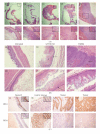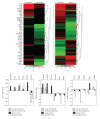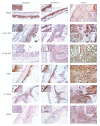Induction of metastatic gastric cancer by peroxisome proliferator-activated receptorδ activation
- PMID: 21318167
- PMCID: PMC3026990
- DOI: 10.1155/2010/571783
Induction of metastatic gastric cancer by peroxisome proliferator-activated receptorδ activation
Abstract
Peroxisome proliferator-activated receptorδ (PPARδ) regulates a multiplicity of physiological processes associated with glucose and lipid metabolism, inflammation, and proliferation. One or more of these processes likely create risk factors associated with the ability of PPARδ agonists to promote tumorigenesis in some organs. In the present study, we describe a new gastric tumor mouse model that is dependent on the potent and highly selective PPARδ agonist GW501516 following carcinogen administration. The progression of gastric tumorigenesis was rapid as determined by magnetic resonance imaging and resulted in highly metastatic squamous cell carcinomas of the forestomach within two months. Tumorigenesis was associated with gene expression signatures indicative of cell adhesion, invasion, inflammation, and metabolism. Increased PPARδ expression in tumors correlated with increased PDK1, Akt, β-catenin, and S100A9 expression. The rapid development of metastatic gastric tumors in this model will be useful for evaluating preventive and therapeutic interventions in this disease.
Figures





References
-
- Lochhead P, El-Omar EM. Gastric cancer. British Medical Bulletin. 2008;85(1):87–100. - PubMed
-
- Forman D, Burley VJ. Gastric cancer: global pattern of the disease and an overview of environmental risk factors. Best Practice and Research: Clinical Gastroenterology. 2006;20(4):633–649. - PubMed
-
- Nishino Y, Inoue M, Tsuji I, et al. Tobacco smoking and gastric cancer risk: an evaluation based on a systematic review of epidemiologic evidence among the Japanese population. Japanese Journal of Clinical Oncology. 2006;36(12):800–807. - PubMed
Grants and funding
LinkOut - more resources
Full Text Sources
Other Literature Sources
Miscellaneous

